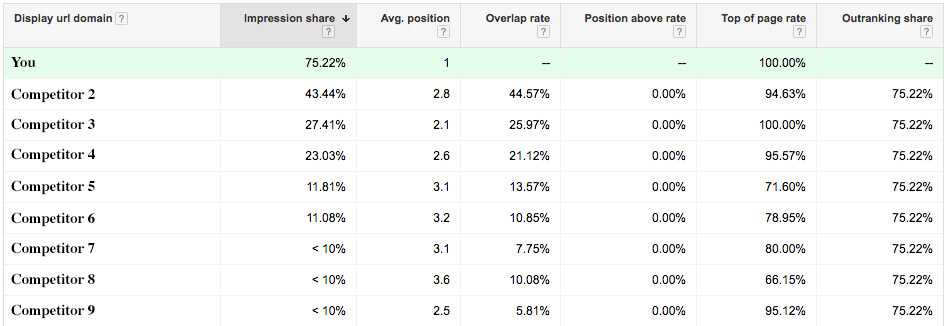
When it comes to any marketing campaign, the impression count is where most people start when determining its success.
“How many people did this postcard go out to?”
“How many eyes saw my commercial?”
While impressions are an important metric for any PPC campaign in determining what our audience is most interested in, it’s the Impression Share that really shows the overall picture of where we are, and where we COULD be.
What Is Impression Share?
To put it simply, Impression Share tells us how often our ads are shown – when searched for using a specific keyword. It’s determined by taking the total number of impressions and dividing it by the total number of eligible impressions, or every impression that you should have received.
What Makes Impression Share So Important?
Any business would like to get in front of as many shoppers’ eyes as possible. Not only will Impression Share tell us where we’re succeeding and where we’re lacking when it comes to overall coverage, it will give us a better idea of what additional opportunities are available for us to grow the campaigns.
Now, many factors play a part in Impression Share, most notably Budget, Location, Rank and Competition.
Budget
- One budget is broken down and allocated to each campaign
- Based on settings, Google will evenly spread the budget throughout each day (standard). Another option is ‘Accelerated’, which spends it as quickly as possible – typically used for a campaign that has difficulty spending
- If more people are searching for your ad than your budget’s equipped for, your ads will not show, resulting in a lower Impression Share
Location
- Typically, targeting a smaller area should result in a higher Impression Share, while broadening the location, or serving your ads in a competition-dense area, could lower it
- Keep budget fluid. A broader targeting area, or one with heavy competition, will most likely necessitate a larger spend
Ad Rank
- Based on a keyword’s Quality Score (Click-Through Rate and Ad Text/Landing Page/Keyword Relevance)
- Low Quality Scores can result in a reduced ad rank, meaning the ad might not show because other, more relevant ads will be prioritized higher. This will create a lower Impression Share
- A low Ad Rank will also prevent ads from being displayed above the fold, or on the first page of search results
Competition
- Increased competition could result in a higher bid for a keyword
- With a lower quality score, your CPC (cost-per-click) will most certainly increase
- A higher CPC will leave your budget to run out early, meaning less time for your ad to show to prospective buyers (low Impression Share)
For details on who, specifically, is bidding on your keywords, we look to Google Auction Insights. Aside from overall Impression Share, other metrics listed include:
- Average Position: Where you rank amongst other paid ads in search results
- Overlap Rate: How often a competitor’s ad showed up in the same search as yours
- Position Above Rate: How often a competitor’s ad ranked higher than yours when both were displayed
- Top of Page Rate: How often your ad, or a competitor’s, received a top-of-page position
- Outranking Share: How often your ad ranked higher than a competitor’s, or if your ad ran and theirs did not

While it won’t directly help in improving your Impression Share, Auction Insights is still a great tool that gives an idea as to how many competitors are bidding on your keywords and where they lie in total Impression Share in relation to you.
How To Improve Your Impression Share
Thankfully, there are guides in which Google helps us understand which areas we’re lacking: Quality (Lost IS – Rank) and Money (Lost IS – Budget).
Money
- Increase Impression Share with additional budget
Quality
- Improve Quality Score, which will help Ad Rank and lower CPC
- Ways to improve Quality Score include:
- Using relevant keywords specific to your ad group (i.e. Don’t use a keyword like ‘Chocolate’ when your ad group is labeled ‘laundry detergent’)
- Make sure your landing pages not only pertain to the keywords, but include those most important to you and your campaign
- Create new ads that contain top performing keywords
Now, does one need a great ad rank and quality score in order to place among the top of a search result? While the logical answer is ‘yes’, the truthful one is ‘not necessarily’ – as long as you have a budget to compensate for the lower score.
An ad’s position is based on Quality Score and bid. If I had a Quality Score of 10/10 and my bid was $3, my overall ‘score’ would be 13 (10 + 3). If I had a Quality Score of 2/10 and a bid of $11, I could theoretically rank just as high as if I had a Quality Score of 10/10 – however it will cost me. Ideally, having a high Quality Score is the best route to go, because it will not only save you money on each click, but it will make your budget go farther, resulting in more impressions and more visits to your website.
The More You Know
As you can see, Impression Share plays a large role in the success of any Pay-Per-Click campaign. If a reduced number of people see your ad, then that leads to less people visiting your site, which turns into lost sales and revenue. The great thing is that with some time, effort and a flexible budget, it can most certainly be improved.
For help in improving your campaign’s overall Impression Share, contact the highly experienced PPC team at Aronson Advertising in Schaumburg, IL.
